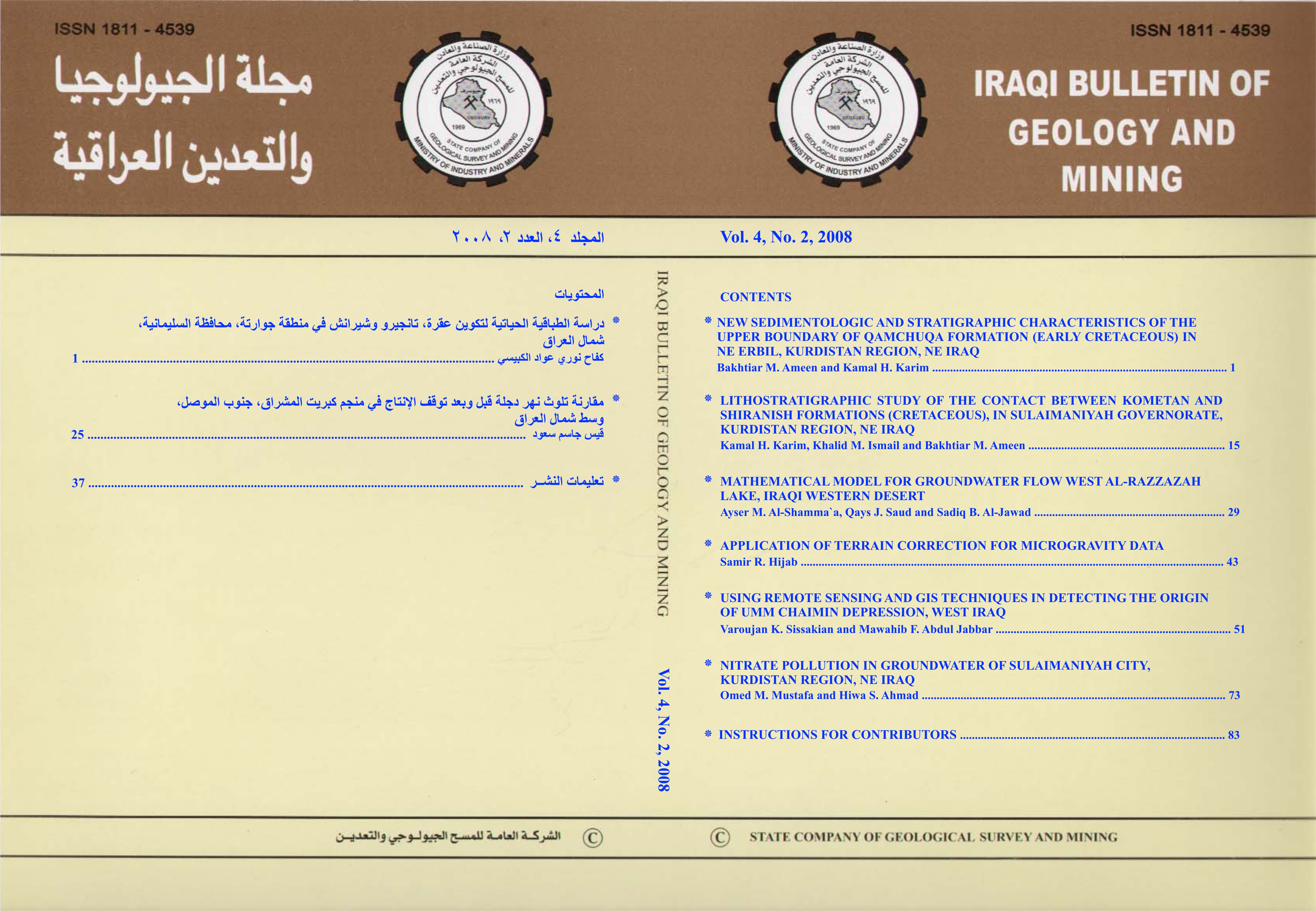Abstract
The contact between Qamchuqa (Early Cretaceous) and Bekhme (Late Cretaceous) formations is studied in the field and laboratory. On lithological basis, the contact is described and analyzed in four different sections. In all four sections, the result of the study showed that the boundary seems to be gradational; two of four sections (Zante gorge and Perse Mountain) are barren of conglomerate, breccias or erosional surfaces, so the contact seems to be conformable in the field. The other two sections (outlet and inlet of Bekhme gorge) contain beds of apparent conglomerate (or conglomerate-like masses), which in the present study are inferred to be not depositional, but diagenetic in origin. They are secondary ball and pillow structures, which formed during burial by lithostatic stress. In the inlet of Bekhme gorge section, there is a mass of breccia (about 1.5 m thick), which is located 10 m above the beds, which include ball and pillow structures. This breccia is not depositional as it consists of extremely angular clasts of limestone. These clasts are believed to be tectonic in origin and derived from younger beds, above the contact, which are not more than 20 m higher from their location. The clasts are transferred to this location, possibly by a reverse fault across Greatyer Zab river.
In contrast to previous studies, the contact suffered from deepening relative to the overlying and underlying Bekhme and Qamchuqa formations, respectively. This is manifested by green marl, marly limestone, limestone bearing planktonic forams and breccias. The soft succession at the boundary (about 30 m thick) is most possibly deposited during the previously suggested gap or unconformity.
In contrast to previous studies, the contact suffered from deepening relative to the overlying and underlying Bekhme and Qamchuqa formations, respectively. This is manifested by green marl, marly limestone, limestone bearing planktonic forams and breccias. The soft succession at the boundary (about 30 m thick) is most possibly deposited during the previously suggested gap or unconformity.
Abstract
درس الحد الفاصل بين تكويني قمجوقة (الكريتاسي المبكر) وبخمة (الكريتاسي الأعلى) من الناحيتين الحقلية والمختبرية. وقد تم وصف وتحليل أربعة مقاطع صخارية في مناطق مختلفة. وفي جميع هذه المقاطع، تبين بان الحد الفاصل قد يكون سطح توافقي، حيث يظهر بشكل واضح بان مقطعي كلي زنطة وجبل بيرس خاليين من المدملكات والبريشيا أو أي سطح للتعرية. وفي المقطعين الآخرين، في مدخل ومخرج كلي بخمة، توجد طبقات تشبه المدملكات. أثبتت الدراسة الحالية بان هذه الطبقات ليست مدملكات رسوبية وإنما هي تراكيب كروية ووسائدية ذات أصل تحويري وليست رسوبية وتكونت من خلال عمليات الدفن العميق. وفي مقطع مدخل كلي بخمة توجد كتلة من البريشيا بسمك 1.5 م تقع فوق الطبقة الكروية والوسائدية بمسافة 10 م. وتعد هذه البريشيا ذات أصل تكتوني وليس رسوبي، حيث تحتوي على فتات من الحجر الجيري ذات زوايا حادة، وان مصدر هذا الفتات هو الصخور الأحدث الواقعة فوق الحد الفاصل بمسافة لا تتجاوز 20 م. حيث نقل الفتات من هذا الموقع، على الأرجح، بواسطة فالق عكسي من المحتمل تواجده في المنطقة.
إن الحد الفاصل بين تكويني قمجوقة وبخمة قد تأثر بعمليات التعمق النسبي للحوض الرسوبي وليس نهوضاً وكما ذكر سابقا. ويظهر هذا واضحاً من خلال وجود الطفل الأخضر والحجر الجيري الذي يحتوي على الفورامينيفرا الطافية والبريشيا. ان التتابع الناعم في الحد الفاصل (بسمك 30 م) قد ترسب، على الأرجح، أثناء فترة عدم التوافق المقترح سابقا.
إن الحد الفاصل بين تكويني قمجوقة وبخمة قد تأثر بعمليات التعمق النسبي للحوض الرسوبي وليس نهوضاً وكما ذكر سابقا. ويظهر هذا واضحاً من خلال وجود الطفل الأخضر والحجر الجيري الذي يحتوي على الفورامينيفرا الطافية والبريشيا. ان التتابع الناعم في الحد الفاصل (بسمك 30 م) قد ترسب، على الأرجح، أثناء فترة عدم التوافق المقترح سابقا.
